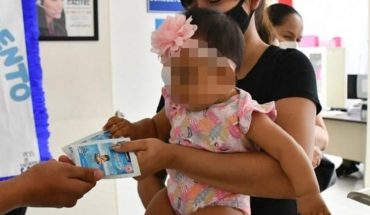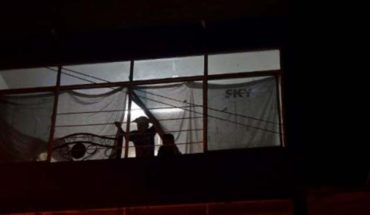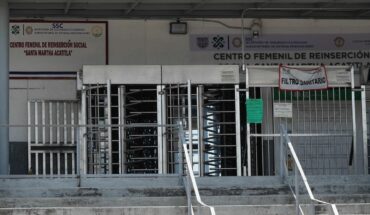Next December 25 will be the fifth Christmas that the civil builder Harry Prado Arrué (36) will spend away from his daughters, from his family. In fact, the 4-year-old had not yet been born on the day her father’s life took an unexpected turn.
On the morning of June 7, 2018, Prado Arrué was arrested for his alleged participation — the day before — in a settling of scores between two rival gangs in La Pintana. Situation in which Corporal Oscar Galindo Saravia was murdered.
His arrest and indictment was based on the recognition, by the victim and target of the shooting, Brayan Alvial Pozo, through a set of photographs that Carabineros showed him. A fact that Alvial Pozo later denied. In addition, he said he had never recognized Prado Arrué and never signed the act of recognition. The problem is that he did all this informally, he never made an official statement, he just disappeared without reappearing. His trail is lost to this day.
Looking for evidence, three expert reports were commissioned with different specialists. All concluded that the signatures were fake. That is, the witness never confirmed the recognition of Harry Prado at the scene of the crime. With this evidence and other testimonies, a complaint was filed – on March 8, 2021 – against those who are responsible for the crime of falsification of a public instrument. The plaintiffs are Harry Prado and Pablo Soto Maturana, also convicted as a co-author for the murder of Corporal Galindo and whose signature on the act of recognition that places him on the scene is also not legitimate.
In charge of the investigation was the chief prosecutor of the Eastern High Complexity Prosecutor’s Office, Felipe Sepúlveda. The investigations led him to charge the deputy prosecutor of the Prosecutor’s Office of Violent Crimes of the Southern Metropolitan Region, Rodrigo Chinchón Soto in charge of the Cape Galindo case and the OS9 carabineros Rodrigo Molina Trujillos, Julio Muñoz Astete and Melanie Ortega Meza, who took the testimony of the witness and would have made the recognition wheel with photographs of the police kardex. The complaint was divided into two: one against the carabineros and another against the prosecutor. The latter was closed, but today there is a request for reopening – which must be reviewed – by the plaintiffs. The case against the police is still under investigation.
From perpetrator to victim
It all started on June 6, 2018. When the carabineros Carlos Bravo and Oscar Galindo appeared unexpectedly in a passage of La Pintana at the right moment when a trio of the band “Los cogote de toro” attacked the member of “Los risas”, Brayan Alvial Pozo, who was injured and fled the place.
At first Carabineros thought that Alvial was part of the attackers and arrested him as a suspect. In that process, Brayan Alvial said — according to victims and witness psychologist Raul Carvacho, who was taking a statement with prosecutor Chinchon — that he suffered illegitimate pressure to confess.
However, after it was determined that Bryan Alvial was the victim and not the perpetrator, -as it appears in the investigation- he became the key witness who recognizes through photographs Harry Prado and Pablo Soto at the scene.
The day after the shooting, the confessed perpetrator of the crime, Daniel Rojas Yáñez (alias Danielito) turned himself in to the PDI. In his seized cell phone appeared the photographic records of those who were with him that day and whom Rojas Yáñez identified as companions: Diego Salvo Cereceda and Cristopher Morel Vásquez. “These co-authors have never been investigated,” says Harry Prado’s lawyer, Claudia Tello.
To identify more participants in the crime along with Danielito, Carabineros looked for associated crimes.
Harry Prado had met Danielito through a nephew, they had acquaintances in common. And they had been stopped together at a traffic stop several years earlier. In addition, Prado had a lesser sentence in 2006. This data included him in the photographic set of suspects.
Fake signatures
The complaint for falsification of public instrument against those who are responsible, indicates that during the development of the investigation of the South metropolitan prosecutor’s office, Prado requested through his defense, on several occasions, diligence of recognition in a round of prisoners considering that only one person would have recognized him through a photographic set and this had done so in front of two police officers in the OS9 premises. (Exequiel Fernández N° 1153, Nuñoa). “My request that the victim witness B.A.A.P. (Brayan Alvial) participated in a reconnaissance proceeding, was never carried out.”
During the oral trial, the victim referred to was presented by the prosecutor, but indicated that he did not wish to give a statement for his safety. “His testimony was my only hope that he could observe me directly and clarify that I had no participation in the facts that are imputed to me,” adds Prado.
In the brief it is stamped that through a fellow prisoner, whose defense lawyer was the same one who represented Alvial, he had expressed his interest in talking with him. “Professional Jeanette Cofré Soto visited him on Saturday, January 16, 2021. Then he told him that although his client had not given a statement in court, he knew that the signatures of the minutes of the recognitions made before police personnel on June 6, 2018, were false since he told him that he had never signed them. That same day, I explained to the professional that my defense would also present it as testimonial evidence in its evidentiary stage and that my only wish was that she could see me since I was sure that I could clarify that I was never at the scene of the facts, “says Harry Prado in the complaint.
This was not possible because Alvial was not there. Likewise, the defender Jeanette Cofré Soto, according to the file, would have confirmed to the friend of the family Aníbal González Terán that the signatures of the acts of recognition were not signed by Alvial Pozo and that this circumstance was known by the prosecutor Rodrigo Chinchón Soto, since his client would have pointed him out in front of her.
“It is possible to point out that the minutes that B.A.A.P. would not have signed and that were allegedly falsified, correspond to the acknowledgments of me and the co-defendants Pablo Soto Maturana and Daniel Rojas. These were carried out on June 6, 2018 by the diligence officer Corporal Julio Muñoz Astete and witness official Corporal 1° Melanie Ortega Meza, in the unit of Carabineros de Chile Criminal Investigation Directorate Dept. Invet. of Org. Criminal, located in the commune of Ñuñoa,” the complaint stipulates.
“When the trial began, we were unaware that the signatures of both the acknowledgment act and the statements were false. To make the expert we toured the portal of the judiciary looking for signatures of Bryan Alvial to collate. Fortunately he was a victim with many causes and in the system there were several sponsorships that had his real signature stamped, “explains Claudia Tello.
The first analysis was made by the expert Marcela Meza Navarrete, who concluded that “the signing of the act of recognition has a great probability of not belonging to the authorship …”.
The second expert was in charge of the expert in documentscopy Rodolfo Sáez Muñoz, who pointed out that it did not come from the hand of Brayan Alvial.
The third calligraphic expert report was made by Miguel Angel Acuña, who pointed out that the signature did not belong to the accused. With that they filed the complaint for forgery.
In the investigation carried out by the eastern metropolitan prosecutor’s office, the PDI Central Criminalistics Laboratory confirmed in an expert opinion that Brayan Alvial’s signature is false. But something else emerged, after examining the documents it was concluded that the signature of the act of recognition of the other convicted as a co-author, Pablo Soto, is also false.
Shot under doubt
After three years of investigation, Prado Arrué was sentenced to 18 years in prison.
In the conviction the judges valued the proof of recognition by Brayan Alvial and the presence of barium in the hands of Prado. An expert that the defense questions with its own investigations. “When a shot is fired, traces of barium, antimony and lead remain. This combination must be present to confirm a shot,” explains Tello.
According to the file, the expert Rodrigo Marcos, determined that although “in both palms maintained levels of barium, these do not meet the scientific standard for the detection of gunshot residues.”
The expert report prepared by Labocar showed positive for barium, but negative for lead and antimony. Prado Arrué’s defense argued that the barium is explained by the defendant’s construction work. In addition, as proof he added “that the civil constructor maintained contracts for works of more than one billion pesos. He didn’t need to commit a crime. In fact, he always cooperated, handing over his cell phone and computers without restriction for expertise. Her alibi was to be playing an online video game at home, but it was not considered because, according to prosecutor Chinchón, anyone could have been using the online account,” adds the lawyer.
Another point, which the lawyer points out is that the active carabinero Carlos Bravo – who accompanied Corporal Galindo – “never identified Harry on the photographic set and lesss at trial. However, the sentence of the judges of the sixth court of the oral trial in the criminal matters of Santiago María Rojas Contreras, Macarena Rubilar Navarrete and Julio Castillo Urra stated the opposite. ”
From the Office of the Prosecutor of High Complexity East only responded that the investigation continues to develop.
Follow us on





